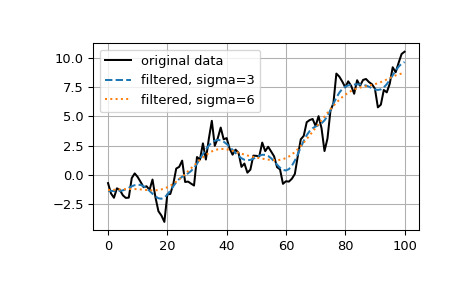本文简要介绍 python 语言中 scipy.ndimage.gaussian_filter1d 的用法。
用法:
scipy.ndimage.gaussian_filter1d(input, sigma, axis=-1, order=0, output=None, mode='reflect', cval=0.0, truncate=4.0, *, radius=None)#一维高斯滤波器。
- input: array_like
输入数组。
- sigma: 标量
高斯核的标准差
- axis: 整数,可选
要计算的输入轴。默认值为 -1。
- order: 整数,可选
0 阶对应于具有高斯核的卷积。正阶对应于具有高斯导数的卷积。
- output: 数组或数据类型,可选
放置输出的数组,或返回数组的 dtype。默认情况下,将创建一个与输入具有相同 dtype 的数组。
- mode: {‘reflect’, ‘constant’, ‘nearest’, ‘mirror’, ‘wrap’},可选
mode 参数确定输入数组如何扩展到其边界之外。默认为‘reflect’。每个有效值的行为如下:
- ‘reflect’ (d c b a | a b c d | d c b a)
通过反射最后一个像素的边来扩展输入。此模式有时也称为half-sample 对称模式。
- ‘constant’ (k k k k | a b c d |呸呸呸呸)
通过使用 cval 参数定义的相同常量值填充边之外的所有值来扩展输入。
- ‘nearest’ (啊啊啊啊| a b c d |嘀嘀嘀嘀)
通过复制最后一个像素来扩展输入。
- ‘mirror’ (d c b | a b c d | c b a)
通过反射最后一个像素的中心来扩展输入。此模式有时也称为whole-sample 对称模式。
- ‘wrap’ (a b c d | a b c d | A B C D)
通过环绕到相对边来扩展输入。
为了与插值函数保持一致,还可以使用以下模式名称:
- ‘grid-mirror’
这是‘reflect’ 的同义词。
- ‘grid-constant’
这是‘constant’ 的同义词。
- ‘grid-wrap’
这是‘wrap’ 的同义词。
- cval: 标量,可选
如果模式为‘constant’,则填充过去输入边的值。默认值为 0.0。
- truncate: 浮点数,可选
在这么多标准偏差处截断过滤器。默认值为 4.0。
- radius: 无或整数,可选
高斯核的半径。如果指定,内核的大小将为
2*radius + 1, 和截短被忽略。默认为“无”。
- gaussian_filter1d: ndarray
参数 ::
返回 ::
注意:
高斯核的大小
2*radius + 1沿着每个轴。如果半径是 None,默认值radius = round(truncate * sigma)将会被使用。例子:
>>> from scipy.ndimage import gaussian_filter1d >>> import numpy as np >>> gaussian_filter1d([1.0, 2.0, 3.0, 4.0, 5.0], 1) array([ 1.42704095, 2.06782203, 3. , 3.93217797, 4.57295905]) >>> gaussian_filter1d([1.0, 2.0, 3.0, 4.0, 5.0], 4) array([ 2.91948343, 2.95023502, 3. , 3.04976498, 3.08051657]) >>> import matplotlib.pyplot as plt >>> rng = np.random.default_rng() >>> x = rng.standard_normal(101).cumsum() >>> y3 = gaussian_filter1d(x, 3) >>> y6 = gaussian_filter1d(x, 6) >>> plt.plot(x, 'k', label='original data') >>> plt.plot(y3, '--', label='filtered, sigma=3') >>> plt.plot(y6, ':', label='filtered, sigma=6') >>> plt.legend() >>> plt.grid() >>> plt.show()
相关用法
- Python SciPy ndimage.gaussian_filter用法及代码示例
- Python SciPy ndimage.gaussian_laplace用法及代码示例
- Python SciPy ndimage.gaussian_gradient_magnitude用法及代码示例
- Python SciPy ndimage.generic_laplace用法及代码示例
- Python SciPy ndimage.generate_binary_structure用法及代码示例
- Python SciPy ndimage.grey_erosion用法及代码示例
- Python SciPy ndimage.generic_filter1d用法及代码示例
- Python SciPy ndimage.generic_gradient_magnitude用法及代码示例
- Python SciPy ndimage.generic_filter用法及代码示例
- Python SciPy ndimage.grey_closing用法及代码示例
- Python SciPy ndimage.grey_opening用法及代码示例
- Python SciPy ndimage.geometric_transform用法及代码示例
- Python SciPy ndimage.grey_dilation用法及代码示例
- Python SciPy ndimage.correlate用法及代码示例
- Python SciPy ndimage.morphological_gradient用法及代码示例
- Python SciPy ndimage.variance用法及代码示例
- Python SciPy ndimage.correlate1d用法及代码示例
- Python SciPy ndimage.binary_dilation用法及代码示例
- Python SciPy ndimage.distance_transform_bf用法及代码示例
- Python SciPy ndimage.find_objects用法及代码示例
- Python SciPy ndimage.label用法及代码示例
- Python SciPy ndimage.maximum_filter1d用法及代码示例
- Python SciPy ndimage.iterate_structure用法及代码示例
- Python SciPy ndimage.map_coordinates()用法及代码示例
- Python SciPy ndimage.binary_opening用法及代码示例
注:本文由纯净天空筛选整理自scipy.org大神的英文原创作品 scipy.ndimage.gaussian_filter1d。非经特殊声明,原始代码版权归原作者所有,本译文未经允许或授权,请勿转载或复制。
